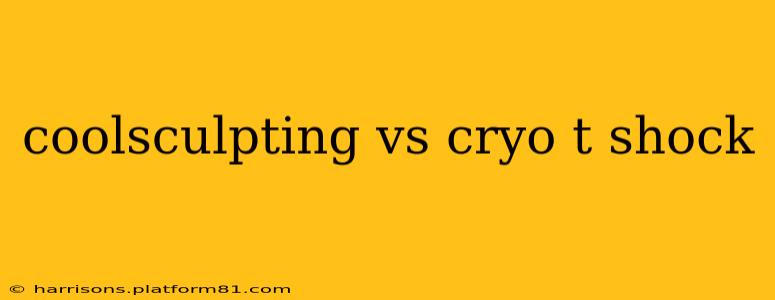Choosing between CoolSculpting and Cryo T Shock for fat reduction can feel overwhelming. Both are non-invasive procedures using controlled cooling to eliminate stubborn fat cells, but they differ significantly in technology, cost, and treatment experience. This comprehensive guide will delve into the key differences, helping you make an informed decision about which procedure best suits your needs and budget.
What is CoolSculpting?
CoolSculpting, developed by Zeltiq Aesthetics, is the gold standard in cryolipolysis. It utilizes a patented cooling technology to freeze and destroy fat cells in targeted areas. The process is FDA-cleared for multiple areas, including the abdomen, flanks ("love handles"), thighs, and chin. The CoolSculpting applicator is carefully placed on the treatment area, and the procedure typically lasts for about 35-75 minutes, depending on the area and size of the applicator used.
What is Cryo T Shock?
Cryo T Shock is a newer technology employing a similar principle of cryolipolysis but with a key difference: it uses a combination of cryolipolysis and radiofrequency (RF) energy. The RF energy is believed to enhance the fat-freezing process and potentially improve skin tightening. Treatment time is often shorter than CoolSculpting, typically around 20-30 minutes per area.
CoolSculpting vs. Cryo T Shock: A Detailed Comparison
| Feature | CoolSculpting | Cryo T Shock |
|---|---|---|
| Technology | Cryolipolysis only | Cryolipolysis + Radiofrequency (RF) energy |
| Treatment Time | 35-75 minutes per area | 20-30 minutes per area |
| Cost | Generally more expensive per treatment | Generally less expensive per treatment |
| Downtime | Minimal to none | Minimal to none |
| Results | Gradual, visible within 2-4 months | Potentially faster results due to RF energy, but individual results vary |
| FDA Clearance | FDA-cleared for various body areas | Not FDA-cleared for the same range of applications as CoolSculpting |
How Much Does CoolSculpting Cost?
The cost of CoolSculpting varies significantly depending on the number of areas treated, the size of the applicators used, and the clinic's location and pricing structure. It's generally considered a more expensive treatment than Cryo T Shock. It's essential to obtain multiple quotes from different providers before making a decision.
How Much Does Cryo T Shock Cost?
Cryo T Shock is typically less expensive than CoolSculpting per treatment session. However, you might need more sessions to achieve comparable results, so the overall cost could become comparable or even exceed CoolSculpting depending on your individual needs.
What is the Recovery Time for CoolSculpting and Cryo T Shock?
Both procedures are non-invasive and boast minimal downtime. You may experience some mild redness, swelling, or bruising immediately following treatment, but these side effects usually subside within a few days. You can generally return to your normal activities immediately after the treatment.
Are There Any Side Effects of CoolSculpting and Cryo T Shock?
While rare, possible side effects for both include temporary numbness, redness, swelling, bruising, and pain. More serious side effects are extremely uncommon but can include paradoxical adipose hyperplasia (PAH), a rare condition where the treated fat cells grow larger. It's crucial to choose a qualified and experienced practitioner to minimize the risk of complications.
Which Treatment is Right for Me?
The best treatment for you depends on your individual needs, budget, and preferences.
-
Choose CoolSculpting if: You prioritize a well-established and FDA-cleared technology with a proven track record of success. You're willing to invest in a potentially more expensive but highly effective treatment.
-
Choose Cryo T Shock if: You're looking for a potentially more affordable option, even if it might require more treatment sessions. You are interested in a treatment that combines cryolipolysis with RF energy for potentially faster results.
Disclaimer: This information is for educational purposes only and does not constitute medical advice. It's crucial to consult with a qualified medical professional to determine the most appropriate treatment for your individual circumstances. They can assess your specific needs, medical history, and goals to recommend the best approach.
